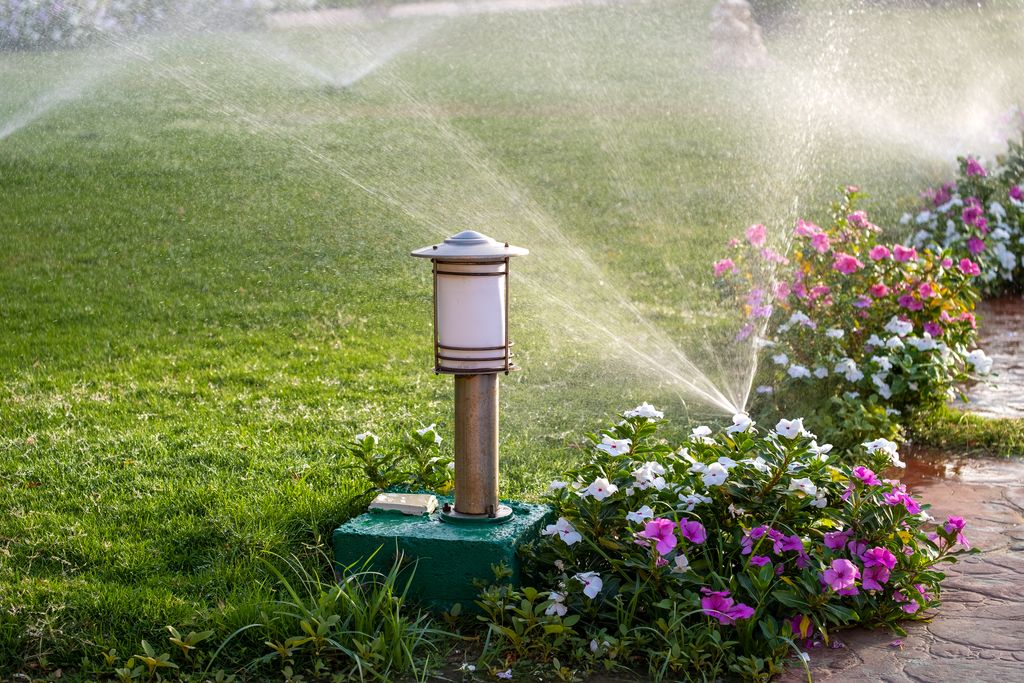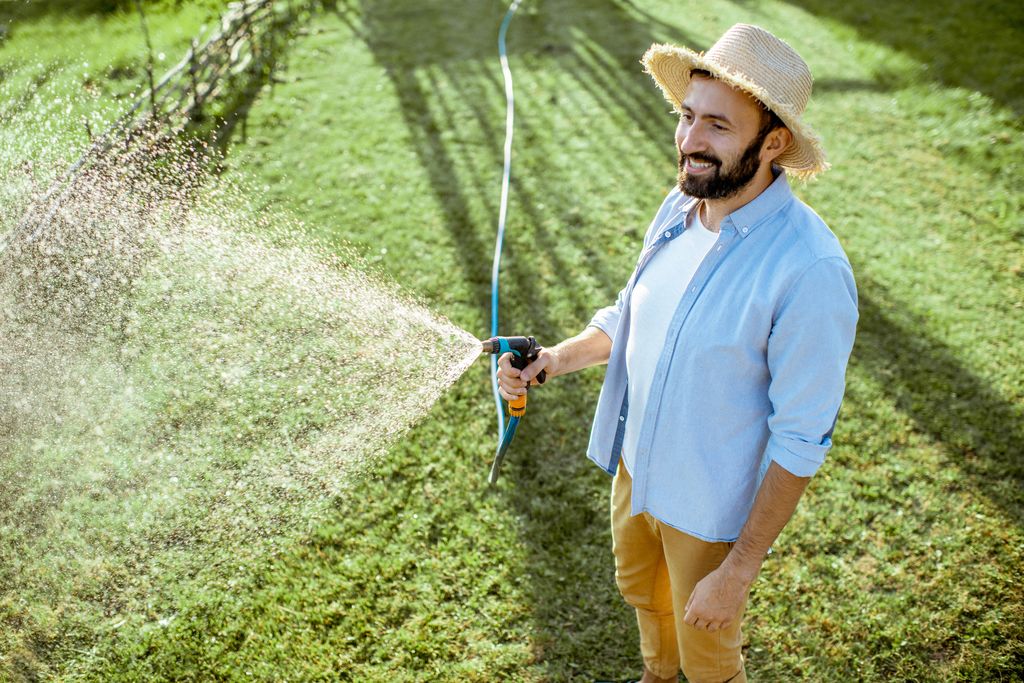Are you tired of guessing when to water your lawn, only to find it either parched or overwatered?
You’re not alone! Many homeowners struggle with the delicate balance of keeping their lawns lush and green without wasting water or damaging their plants.
In this post, we’ll explore the ins and outs of Lawn Irrigation scheduling, helping you figure out the best times and frequencies to keep your grass healthy and thriving.
This post contains affiliate links. As an Amazon Associate, I earn from qualifying purchases at no additional cost to you.
Understanding Lawn Irrigation

Lawn irrigation refers to the artificial application of water to soil or land to assist in the growing of crops and vegetation.
For homeowners, it’s all about establishing a routine that ensures your lawn gets the right amount of water at the right time.
This not only promotes a healthier lawn but also conserves water and reduces your utility bills.
Why Is a Watering Schedule Important?

A well-planned watering schedule can lead to:
- Water Conservation: Proper scheduling minimizes water waste.
- Healthy Grass: Regular watering promotes deep root growth.
- Weed Control: Consistent moisture can help suppress weeds.
- Cost Savings: Reduces water bills by preventing overwatering.
Key Factors to Consider for Your Lawn Irrigation Schedule

Before diving into a watering routine, it’s important to consider a few key factors that can influence how often and when you should water:
| Factor | Impact on Watering Schedule |
|---|---|
| Soil Type | Clay soils retain moisture longer, while sandy soils drain quickly. |
| Grass Type | Some grass varieties require more water than others. |
| Climate | Hotter climates may need more frequent watering. |
| Season | Lawns often need less water during cooler months. |
How Often Should You Water Your Lawn?

When it comes to Lawn Irrigation, the general rule of thumb is to water deeply and infrequently to encourage strong root growth.
Here’s a simple guideline:
| Lawn Type | Watering Frequency |
|---|---|
| New Lawns | Water daily for the first 2 weeks, then reduce gradually. |
| Established Lawns | 1 to 1.5 inches of water per week, including rainfall. |
| Seasonal Adjustments | Water more in summer; reduce watering in fall and winter. |
A neighbor of mine once watered his lawn every day, thinking more water would make it lusher.
But his grass became shallow-rooted and vulnerable to drought.
After switching to less frequent, deeper watering, his lawn became healthier and more drought-resistant.
His lesson: more water isn’t always better!
Best Times to Water Your Lawn

The timing of your irrigation is just as important as the frequency.
Watering at the right time can maximize absorption while reducing water loss through evaporation.
Here are the best times to water:
- Early Morning (4 AM – 10 AM): Ideal for cooler temperatures and minimal wind, to maximize water absorption.
- Evening (6 PM – 10 PM): Offers a good chance for absorption, but avoid overwatering to prevent fungal diseases.
- Midday: Generally not recommended due to high evaporation rates leading to water waste.
Practical Tips:
- Use a Timer: If you use an irrigation system, set it to run early in the morning for the most efficient watering.
- Watch the Wind: Avoid watering on windy days, as it can cause uneven water distribution.
- Avoid Overwatering: Too much water at night can lead to fungal issues, especially in humid climates.
Creating Your Lawn Irrigation Schedule

Ready to create your perfect lawn irrigation schedule?
Follow these simple steps:
- Assess Your Lawn: Determine soil type, grass variety, and current moisture levels.
- Set a Watering Goal: Aim for 1 to 1.5 inches of water per week.
- Choose Your Times: Select early morning or early evening for watering sessions.
- Monitor Weather Conditions: Adjust your schedule based on rainfall and temperature changes.
- Test and Adjust: Keep an eye on your lawn’s health and make adjustments as needed.
Tips for Efficient Lawn Irrigation

To maximize the effectiveness of your Lawn Irrigation, consider these handy tips:
- Use a Rain Gauge: This helps you measure how much water your lawn receives.
- Morning Watering: Water early in the day to reduce evaporation and fungal growth.
- Group Plants Wisely: Water similar plants together to avoid over or under-watering.
- Check for Leaks: Regularly inspect your irrigation system for leaks or blockages.
- Mulch Your Lawn: A layer of mulch can retain moisture and reduce the need for frequent watering.
- Test Soil Moisture: Stick a screwdriver into the soil; if it goes in easily, no need to water.
Conclusion
Establishing an effective lawn irrigation schedule is key to achieving a beautiful and healthy lawn.
By considering factors such as soil type, grass variety, and climate, you can create a personalized watering plan that conserves water and keeps your grass looking its best.
Remember to monitor your lawn’s health and adjust your schedule as needed.
With a little effort, you can enjoy a lush green lawn while saving water and money. So grab that watering can or adjust your sprinklers—your lawn will thank you!
F.A.Q
1. How often should I water my newly planted lawn?
For new lawns, it is recommended to water daily for the first two weeks to ensure proper establishment. After this period, you can gradually reduce the frequency as the grass takes root.
2. What time of day is best for watering my lawn?
The ideal times to water your lawn are early morning (between 4 AM and 10 AM) and early evening (between 6 PM and 10 PM). These times help maximize water absorption and minimize evaporation.
3. How can I determine how much water my lawn needs each week?
Aim to provide your lawn with 1 to 1.5 inches of water per week, including rainfall. You can use a rain gauge to measure how much water your lawn receives from both irrigation and natural precipitation.
4. What factors should I consider when creating my lawn irrigation schedule?
Key factors include soil type (clay vs. sandy), grass type (varieties require different amounts of water), climate (hotter areas may need more frequent watering), and season (cooler months typically require less water).
5. How can I make my lawn irrigation more efficient?
To enhance efficiency, use a rain gauge, group similar plants for watering, regularly check for leaks in your irrigation system, and apply mulch to retain moisture in the soil.


